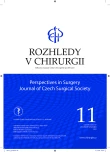Trauma of the extracranial cerebral arteries due to injuries of the cervical spine
Authors:
Ľ. . Hajnovič 1; V. Šefránek 2; L. Schütz 1
Authors‘ workplace:
Klinik für Orthopädie, Unfall- und Handchirurgie, Klinikum Chemnitz
1; Slovenská zdravotnícka univerzita Bratislava
2
Published in:
Rozhl. Chir., 2018, roč. 97, č. 11, s. 504-508.
Category:
Original articles
Overview
Introduction:
Cervical spine injuries are immanently accompanied by trauma to cerebral neck arteries.
Method:
A prospective two-cohort study, from oct. 2013 to oct. 2015. Overall 76 Patients (39W/37M) of median age 77 years, with either fractures or discoligamentary injuries have been examined with duplex-sonography and or CT-angiography. From October 2013 to October 2017 we examined 155 Patients (49% female and 51% male), with the average age of 39 years, SD 19 and age median of 34 years, with cervical-spine-distortion, using the same diagnostic modalities. We used the statistics-program Bias 11.01.
Results:
The overall incidence of traumatic dissection of the internal carotid artery was 2.5%, in 50% of cases (1.2%) with neurological symptomatology. For the vertebral artery seems the incidence of 10.5%, with 25% of symptomatic patients (2.6%) comparably high.
We have identified the osteophytes and dislocation as the significant risk factors. The canalis vertebralis and the skull-base are regions mostly prone to vascular injury. In the group of cervical spine distorsions we found no vascular trauma at all. The osteophytes were here identified as the main risk factor for collateral damage.
Conclusion:
One should look for vascular injuries in case of cervical relevant spine trauma. Moreover, a rather relevant osteoligamentous injury should be assumed, when cervical vascular trauma was diagnosed.
Key words:
cervical spine trauma − vessel-dissection − duplex-sonography − CT-angiography
Sources
1. Hege L, Syed A, Mujtaba R, et al. The epidemiology of traumatic cervical spine fractures: a prospective population study from Norway. Scandinavian Journal of Trauma, Resuscitation and Emergency Medicine 2012;20:85.
2. Kaye JJ, Nance EP. Thoracic and lumbar spine trauma. Radiol Clin North Am 1990;28:361–77.
3. Grümbel D, Naundorf M, Napp N, et al. Diagnostik und Management peripherer Gefäßverletzungen. Der Unfallchirurg 2014;117:445−60.
4. Cogbill Th, Moore EE, Meissner M, et al. The spectrum of blunt injury to the carotid artery: A multicenter prespective. J Trauma 1994;37:473−9.
5. Chrast B, Korbicka J. Die Beeinflussung der Strömungsverhältnisse in der Arteriavertebralis durch verschiedene Kopf- und Halshaltungen. Journal of Neurology 1962;183:426−48.
6. George B, Laurian C. The vertebral artery pathology and surgery. Springer 1987:90−7, ISBN 3-211-81968-1.
7. Vlajic I, Distelmaier P. Traumen der Halswirbelsäule und Kompression der Vertebralarterien. Minim Invasive Neurosurg 1978;21:22−127.
8. Dorndorf, W, Gänshirt, H. Die Klinik der arteriellen zerebralen Gefäßverschlüsse. Der Hirnkreislauf. Thieme 1972:512–629.
9. Myiachi S, Okamura K, Watanabe M, et al. Cerebellar stroke due to vertebral artery occlusion after cervical spine trauma. Spine 1994;19:83−8.
10. Meier DE, Brink BE, Fry WJ. Vertebral artery trauma. Arch Surg 1981;116:236−9.
11. Cooper Z, Gross, JA, Lacey JM, et al. Identifying survivors with traumatic craniocervical dissociation: a retrospective study. The Journal of surgical research 2010;160:3–8.
12. Driessen A, Probst C, Sakka SG, et al. Bilaterale Karotisdissektion eines Kitesurfers durch Strangulation mit Kiteleinen. Unfallchirurg 2015;118:567–70.
13. Pötsch L, Bohl J. Traumatic lesion of the extracranial vertebral artery-a noteworthy potentially lethal injury. Deutsche Zeitschrift für die Gesamte Gerichtliche Medizin 1994;107:99−107.
Labels
Surgery Orthopaedics Trauma surgeryArticle was published in
Perspectives in Surgery

2018 Issue 11
Most read in this issue
- Dunbar syndrome – single-center experience with surgical treatment
- Hypogastric artery aneurysm – a case report
- Trauma of the extracranial cerebral arteries due to injuries of the cervical spine
- Indications to open surgical revascularization of visceral arteries in the endovascular era
